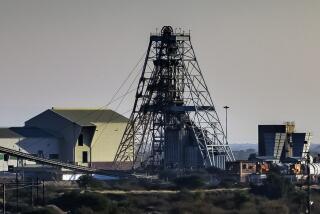76 Blacks Hurt in S. Africa Strike Violence
- Share via
JOHANNESBURG, South Africa — Police fired rubber bullets early Friday at 700 striking black miners, injuring 76 of them, in the most serious clash yet in the increasingly violent, six-day-old strike at more than a third of South Africa’s gold and coal mines.
The miners, reportedly armed with clubs, machetes and gasoline bombs, had advanced on the police and mining security forces before dawn at the Western Deep Levels gold mine, west of Johannesburg, and had begun to stone them, according to Anglo American Corp., the mine owner. When they refused to disperse, the police opened fire, a company spokesman said.
The National Union of Mineworkers accused Anglo American, which has been hit hardest by the work stoppage, of using force at Western Deep Levels and elsewhere in an attempt to break a strike that, from its outset, has been seen as a test of strength between South Africa’s powerful mining houses and their black workers.
“Anglo’s willingness to call in the police,” said Marcel Golding, the union’s deputy general secretary, “is ample evidence that they are relying on the state to break a legal and peaceful strike.”
Explains Firm’s Action
Peter Gush, the head of Anglo American’s gold division, rejected the union allegation as “totally devoid of truth” and said that the company called for police assistance only “as a last resort when striking workers have become uncontrollable and threaten life and property.”
“If striking workers behaved in a peaceful manner, security action would have been unnecessary,” Gush said.
Union officials said the strikers at Western Deep Levels had stayed awake through the night, singing “freedom songs,” as they waited for an expected attack by pro-government vigilantes they had seen on mine property earlier Thursday. The miners apparently were prepared to fight off that attack when mine security forces and then the police attempted to disperse and disarm them.
Concerned by the growing violence as well as by the continued impasse in negotiations, the union’s 300-member central committee will meet over the weekend to review its strategy.
“We have to decide how to protect our members,” union president James Motlatsi said. “We may have to change our strategy.”
66% Reported on Strike
The strike appears to be growing, according to a survey by the independent Labor Monitoring Group, which found that 334,640 miners, or 66% of the work force, had gone on strike at 59 gold and coal mines.
But the South African Chamber of Mines, an organization of the six major mining houses, asserted that miners were beginning to return to work in many areas and that only a third of the country’s mines had been closed. The chamber nevertheless acknowledged that about 40% of the total black work force of 600,000 miners were still on strike.
Most of the serious clashes since the strike began late Sunday have been at Anglo American’s mines and plants, but the violence appears to be spreading to other areas.
Twenty-seven more miners were injured Friday afternoon at the Optimum colliery near Middleburg in eastern Transvaal province when police fired 42 tear gas grenades to disperse 800 strikers--and mine security forces, according to police, then opened fire with shotguns as they fled. Thirteen miners were wounded with birdshot, a police spokesman said, and 14 more were injured in the resulting stampede.
Five workers who had refused to join the strike at another coal mine in the eastern Transvaal were hospitalized, one in serious condition, after being poisoned, apparently by insecticides. Police said they were holding two other workers for questioning in the case.
250 Miners Injured
More than 250 miners have been injured, mostly as a result of police or mine security force actions, in the escalating violence, and one has been killed, apparently murdered by co-workers as a strikebreaker. Police have arrested more than 200 others, including 78 who have been charged with subversion and plotting to murder strikebreakers.
Controversy continued, meanwhile, over the Thursday eviction by riot police of 400 striking workers from two processing plants of the East Rand Gold & Uranium Co., an Anglo American subsidiary at Springs, east of Johannesburg. Twenty-three men were arrested as police broke up sit-ins at the plants.
Nineteen workers, most of them badly bruised and a few still bleeding from open wounds, told a press conference organized Friday by the union that they had been beaten by police and mine security officials after they voted to join the mine workers strike and began the sit-in. They said they had tried to leave the two plants as police fired volleys of tear gas and rubber bullets, found the gates locked and were then set upon by police and mine security.
Blames Police, Guards
Golding, rejecting company charges both of sabotage and of “intimidation” of non-striking workers, said: “Anglo is trying to portray a picture of (the union) as an organization involved in violence and intimidation. We totally reject this. . . . Virtually all the injuries to date have been caused by trigger-happy police and mine security.”
The union is seeking a 30% pay increase for its members as well as safer working conditions, danger pay and improved benefits. The mining companies unilaterally implemented pay increases of 15% to 23% and declared that their “final offer.” Negotiations broke down last month, with each side accusing the other of refusing to bargain in good faith.
The chamber said the average black miner now earns about $250 a month in gold mines and $300 in coal mines--about a fifth of what a white miner is paid. The union says that, before the pay increase in July, the average miner earned only $170 a month. Black miners do most of the underground work, except blasting; white miners act as supervisors and hold technical positions.
More to Read
Sign up for Essential California
The most important California stories and recommendations in your inbox every morning.
You may occasionally receive promotional content from the Los Angeles Times.










